Oakwood Hospital
Oakwood Hospital in Barming Heath near Maidstone, England was a psychiatric hospital founded in 1833 as the Kent County Lunatic Asylum to an Early Corridor design by the Surveyor to the County of Kent, John Whichcord Snr.[1] In the mid-nineteenth century, the superintendent of the asylum was Dr James Huxley (1821-1907), the elder brother of Thomas Henry Huxley, the evolutionary biologist and friend of Charles Darwin. Following transfer of services to Maidstone General Hospital, Oakwood closed in 1994, and was then developed as a residential estate known as St Andrew's Park.
History
The Oakwood Hospital was originally founded as the "Kent County Lunatic Asylum".[2] It was erected between 1829 and 1833 on a site in Barming Heath, just to the west of Maidstone. It comprised one building; commonly referred to as St Andrew's House,. The asylum was intended to take in patients from across the entire county of Kent, which then stretched as far west as Greenwich. The first 168 patients were admitted in 1833.[3] As the asylum expanded, additions and extensions were made to this building until it had reached maximum potential capacity. In 1850 an additional building, known as The Queen's House, was built on newly acquired land at the site. Both of these buildings were designed by the architect John Whichcord Snr (who also designed Maidstone County Gaol). Further expansion took place between 1867 and 1872 with the building of the third asylum block (also known as the New Building or Hermitage Block).
By 1948, Oakwood held 2,000 patients. On 29 November 1957, a fire broke out in the tailor's workshop on the first floor of one of the buildings. The fire brigade was called at 06:40 and arrived four minutes later. Six pumps attended and the 350 patients in that wing were evacuated. By 08:00 the fire was out, and the clearing-up process began. The block had been gutted but a 120-foot (37 m) tall ventilation tower seemed to have survived unscathed. At 10:00, the tower collapsed, killing four firemen, two nursing staff and a patient and injuring a number of people.
Closure
During the 1970s and 1980s there was a change in focus on the best way to treat the mentally ill and housing patients long-term in large institutions was falling out of favour. It was therefore inevitable that the Oakwood Hospital would close or see a change in its role.
Plans for a new hospital for Maidstone were approved in the mid-1970s and the site chosen was just to the north of the Oakwood Hospital. Construction on the Maidstone Hospital began in 1980 and was completed in 1982/1983. The Oakwood Hospital then became known as the Maidstone Hospital (Psychiatric Wing) and some of its functions began to be transferred across to the new hospital.
The Maidstone Health Authority Operational Plan for 1984/85 (paragraph 4.2) states that the long term objective was to close the Oakwood Hospital. The publication of the Short Term Program for 1986-87/1987-88 (paragraph 6.7) recommends the closure of St Andrew's House which by that time had ten wards (nine for Medway Health authority patients and one for all user authorities) and 186 patients. The Program acknowledged that this closure would accelerate the strategic objective of vacating the total site.
Final closure of the Oakwood Hospital came in the 1990s when all its remaining functions had been transferred to the Maidstone Hospital. After the closure, there were a spate of arson attacks on the buildings and on 11 May 1997, work began to demolish the Hermitage Block and other unused buildings.
St Andrew's House,[4] The Queen's House,[5] The Beeches (formerly the Superintendent's House),[6] the stone gate piers (at the entrance) and 2 Lodges (within the grounds) [7] are all Grade II listed buildings and so were all spared demolition.
St Andrew's House was converted into apartments in 2001-2002, after some £60,000 was spent by a specialist firm to landscape the grounds which had become overgrown. The Queen's House, Beeches and the lodges was sold off in April 1997, and was soon then turned into residential use. A new housing development now occupies the site of the demolished Hermitage Block.
Part of the grounds of the Hospital (near St Andrew's Road) were sold. Part of it later became the garden of the Blackthorn Trust.
St Andrew's House - life after closure
St Andrew's House was converted into apartments in 2001-2002. The exterior of the rear of the building has changed little since its construction it the 1830s. The small high windows were replaced by 12 pane replica sash windows following conversion for residential use. New communal bin stores have been built, the prominent octagonal chimney stack has been removed and to the rear of the building is the residents' car park.
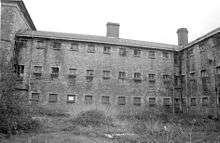
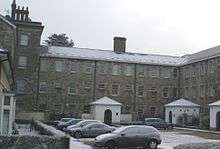
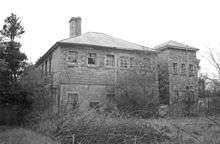
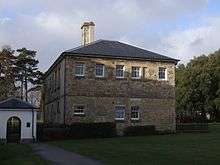
The refractory ward for women is a detached building and a report from July 1859 labels it as "noisy ward women". A free standing building to the right of the refractory ward was built late in the 19th century and appears to have been a toilet block. This was demolished upon conversion to apartments. Little structural changes were made to the refractory building aside from replacement windows and the opening up/bricking up of existing windows.
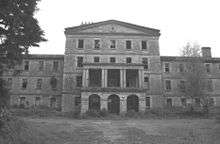
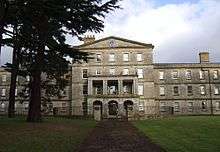
See also
References
Notes
- ↑ "County Asylums". www.countyasylums.com. Retrieved 2009-03-12.
- ↑ "Index of Lunatic Asylums and Mental Hospitals". www.studymore.org.uk. Retrieved 2011-05-29.
- ↑ Ingleton, Roy (2010). Kent Disasters. Barnsley: Pen & Sword. pp. 18–20. ISBN 978-1-84563-116-1.
- ↑ "St Andrew's House at Oakwood Hospital, Maidstone". www.britishlistedbuildings.co.uk. Retrieved 25 March 2012.
- ↑ "Queens House at Oakwood Hospital, Maidstone". www.britishlistedbuildings.co.uk. Retrieved 25 March 2012.
- ↑ "The Beeches at Oakwood Hospital, Maidstone". www.britishlistedbuildings.co.uk. Retrieved 25 March 2012.
- ↑ "Gate and Lodges of Oakwood Hospital, Maidstone". www.britishlistedbuildings.co.uk. Retrieved 25 March 2012.
Bibliography
- A History Of Oakwood Hospital 1828-1982 Kent County Council ISBN 0-905155-45-9
- Queen's House, Oakwood Hospital : Building Investigation Oxford Archaeological Unit 1998
- St Andrew's House, Oakwood Hospital : Historic Buildings Report Oxford Archaeological Unit 2002
- Archive collection held at the Centre For Kentish Studies in Maidstone
- Kent Today newspaper 10 April 1997
External links
| Wikimedia Commons has media related to Oakwood Hospital, Barming Heath. |
Coordinates: 51°16′9″N 0°29′7″E / 51.26917°N 0.48528°E